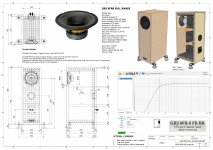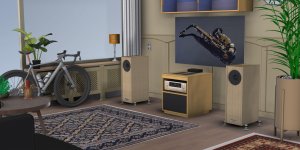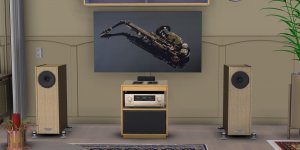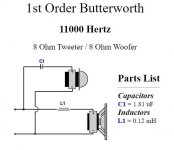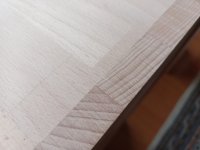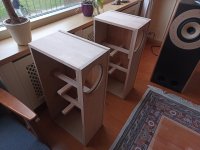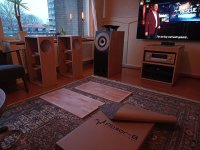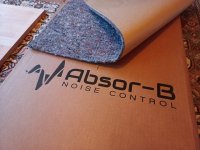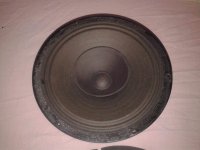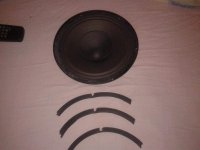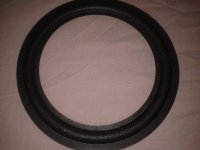Foam is lighter than rubber and the termination of the cone edge is different depending on mass and resisitive losses in the rubber/foam edge. So it all depends on application.
Foam is known to have the lowest inner resistance (less losses) and good damping. Textile surround has also low resistance (less losses) but no damping. Rubber has more losses than foam but good damping, too.
However the longest lasting surrounds which withstand aging is paper and textile surround.
My personal favorite is textile surround.
It's lightweight does not have much losses and lasts for very long time.
However the longest lasting surrounds which withstand aging is paper and textile surround.
My personal favorite is textile surround.
It's lightweight does not have much losses and lasts for very long time.
Started with the cabinets.
Some little modifications due to availability of wood in my garage.
Hole for the port has to be added yet.
Maybe better position at the rear?
Some little modifications due to availability of wood in my garage.
Hole for the port has to be added yet.
Maybe better position at the rear?
Attachments
-
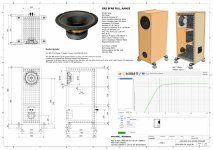 GRS 8FR8 full range BR cabinet_page-0001 (1).jpg386.2 KB · Views: 318
GRS 8FR8 full range BR cabinet_page-0001 (1).jpg386.2 KB · Views: 318 -
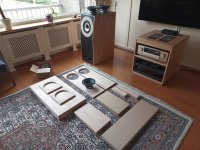 IMG_20230305_153519.jpg518.9 KB · Views: 268
IMG_20230305_153519.jpg518.9 KB · Views: 268 -
 IMG_20230305_153535.jpg521.6 KB · Views: 212
IMG_20230305_153535.jpg521.6 KB · Views: 212 -
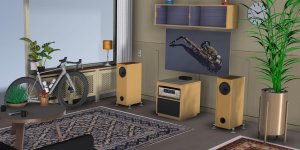 Opstelling GRS 8FR8.jpg317.6 KB · Views: 192
Opstelling GRS 8FR8.jpg317.6 KB · Views: 192 -
 Opstelling GRS 8FR8-2.jpg197.5 KB · Views: 191
Opstelling GRS 8FR8-2.jpg197.5 KB · Views: 191 -
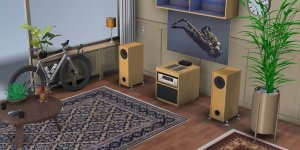 Opstelling GRS 8FR8-3.jpg364.4 KB · Views: 260
Opstelling GRS 8FR8-3.jpg364.4 KB · Views: 260
Wood looks great.
A professional for loudspeakers recommended me after thorough listening tests: best is reflex close to the driver concerning homogeneity in sound. Here you have some small efficiency gain due to coupling diaphragm with reflex port.
For even more bass the reflex should be close to the floor.
For those who seek no mid tone emission from reflex to be audible put reflex on floor height on the backside of enclosure
A professional for loudspeakers recommended me after thorough listening tests: best is reflex close to the driver concerning homogeneity in sound. Here you have some small efficiency gain due to coupling diaphragm with reflex port.
For even more bass the reflex should be close to the floor.
For those who seek no mid tone emission from reflex to be audible put reflex on floor height on the backside of enclosure
What I do to bring fullrange drivers to the top class in sound is:
You get absolute high end with these tweaks as one way drivers naturally have good transient and time domain response, something you would need until today uncommon fir dsp equalizing for multi way speakers. 99.9 % of all multi way speakers produce time smear. It means less dynamics and it never sounds really correct.
One way drivers are more easily to measure and adjust with dsp as you can measure in the near field ie 20cm close to the driver.
This is an argument to put reflex to the front close to the driver so you can measure combined output
However fo a fun box all this is not necessary.I like you invest into good woodwork
- dsp assistance
- Aluminium foil on one or both sides of the cone
- current drive amplifier
You get absolute high end with these tweaks as one way drivers naturally have good transient and time domain response, something you would need until today uncommon fir dsp equalizing for multi way speakers. 99.9 % of all multi way speakers produce time smear. It means less dynamics and it never sounds really correct.
One way drivers are more easily to measure and adjust with dsp as you can measure in the near field ie 20cm close to the driver.
This is an argument to put reflex to the front close to the driver so you can measure combined output
However fo a fun box all this is not necessary.I like you invest into good woodwork
I think then I reposition the port to the back of the cabinet and closer to the driver.hWood looks great.
A professional for loudspeakers recommended me after thorough listening tests: best is reflex close to the driver concerning homogeneity in sound. Here you have some small efficiency gain due to coupling diaphragm with reflex port.
For even more bass the reflex should be close to the floor.
For those who seek no mid tone emission from reflex to be audible put reflex on floor height on the backside of enclosure
The speaker looks also nicer and cleaner.
More output then with help of the wall behind te speaker?
Attachments
If the port is close to any room boundary you get +3db. If you put a box with reflex on floor height close to the back wall +6db - in the corner +9db.
However some frequencies profit a bit more so correction with Dsp or eq can bring the overall balance back all this with gain in efficiency.
If you cannot measure and adjust you can only experiment where it sounds best in the room
However some frequencies profit a bit more so correction with Dsp or eq can bring the overall balance back all this with gain in efficiency.
If you cannot measure and adjust you can only experiment where it sounds best in the room
Well presented
Well presented info Dave, even makes sense to me the way you say it outGuidline 1: braces should be placed such that the subpanels created by the brace should have an aspect ratio larger than the panelbeing braced.
This is clearly not the case in your design, where the aspect ratios are all less. You want to push resonances up in frequency where they will be less likely to get excited.
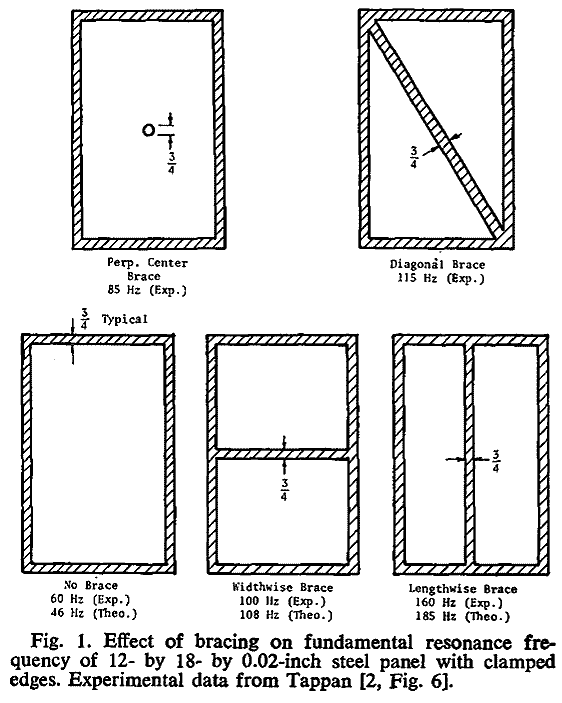
A reflex box is assummed to be “close" to a cube. As one dimension grows a quarter-wave resonance starts across the longest dimension. Your box is tall enuff vrs width/depth that it will be an ML-TL. The end-loaded driver and vent will maximize the quarter-wave effect.
dave
Easy-peasy way to look at it is, which orientation is most appropriate relative to gravity regardless of aspect ratio?
Maybe in the future, if this project has finished, I like to add a separate additional small tweeter cabinet loose on top of this cabinet for experimenting.
I'm thinking about the GRS 1TD2-8.
This in combination with a very cheap and simple crossover.
Frequence response of the GRS 8FR-8: 39 to 16.000 Hz - 91 dB 1W/1m - 60 Watt RMS
Frequence response of the GRS 1TD2-8: 2.100 to 20.000 Hz - 90 dB 1W/1m - 60 Watt RMS
I'm thinking the crossover point about 11.000 Hz will be okay?
1st or 2st order?
Unfortunately I can't find curves of the drivers.
I'm thinking about the GRS 1TD2-8.
This in combination with a very cheap and simple crossover.
Frequence response of the GRS 8FR-8: 39 to 16.000 Hz - 91 dB 1W/1m - 60 Watt RMS
Frequence response of the GRS 1TD2-8: 2.100 to 20.000 Hz - 90 dB 1W/1m - 60 Watt RMS
I'm thinking the crossover point about 11.000 Hz will be okay?
1st or 2st order?
Unfortunately I can't find curves of the drivers.
Attachments
Last edited:
Some Pioneer BOFU measurements the GRS claims to replace.......
Anyway, it's a good plan to be at least -24 dB @ Fs/1,050 Hz:
2^4 = 16,800 Hz/1st
2^2 = 4,200 Hz/2nd
sqrt(2*2^2) = ~2,970 Hz/3rd
2^1 = 2,100 Hz/4th
Which falls right in line with its rated 2,100 Hz lower limit.
The GRS 8FR-8 1.5"/3.81 cm voice coil (VC) frequency = 34400/pi/3.81 = ~2,874 Hz and skipping over a lot of repetitive math, the closest polar matching octave spread to the tweeter's 2,100 Hz is ~2,196 Hz, so 1st order = (2,196/2)*2^4 = 17,568 Hz.
Anyway, it's a good plan to be at least -24 dB @ Fs/1,050 Hz:
2^4 = 16,800 Hz/1st
2^2 = 4,200 Hz/2nd
sqrt(2*2^2) = ~2,970 Hz/3rd
2^1 = 2,100 Hz/4th
Which falls right in line with its rated 2,100 Hz lower limit.
The GRS 8FR-8 1.5"/3.81 cm voice coil (VC) frequency = 34400/pi/3.81 = ~2,874 Hz and skipping over a lot of repetitive math, the closest polar matching octave spread to the tweeter's 2,100 Hz is ~2,196 Hz, so 1st order = (2,196/2)*2^4 = 17,568 Hz.
Really nice woodwork. This is my weak point.
For that I usually build small boxes and correct via dsp the loss in frequency response. It is much easier to build a small enclosure and you can carry it much better.
While using an enclosure which is too small you gain efficiency in the upper bass region where it is of profit (take into accout average amplitude statistics in music). And you lose efficiency in the lower lows which can be corrected for.
However you always need more potent amplifiers for doing this trick. And it can be you have to use passive radiator instead of simple reflex because its impossible to dimension the reflex port properly.
Here I discuss the effect of small enclosures. Its my 18inch build I show here
https://www.diyaudio.com/community/...how-off-my-new-18in-build.365764/post-6767025
For that I usually build small boxes and correct via dsp the loss in frequency response. It is much easier to build a small enclosure and you can carry it much better.
While using an enclosure which is too small you gain efficiency in the upper bass region where it is of profit (take into accout average amplitude statistics in music). And you lose efficiency in the lower lows which can be corrected for.
However you always need more potent amplifiers for doing this trick. And it can be you have to use passive radiator instead of simple reflex because its impossible to dimension the reflex port properly.
Here I discuss the effect of small enclosures. Its my 18inch build I show here
https://www.diyaudio.com/community/...how-off-my-new-18in-build.365764/post-6767025
Today many professional producers use this method for making their enclosures more compact.
And big companies like RCF now tell openly that FIR dsp correction makes the sound better.
Long long time technicians denied and opposed the fact that phase faults in multi way loudspeakers have any relevance.
RCF here explains the effects of faults in the time domain (of all multi way loudspeakers).
And big companies like RCF now tell openly that FIR dsp correction makes the sound better.
Long long time technicians denied and opposed the fact that phase faults in multi way loudspeakers have any relevance.
RCF here explains the effects of faults in the time domain (of all multi way loudspeakers).
Some progress on the cabinets.
Secretly done the knock test carefully.
Sounds good so far.
M curious 😀.
Damping materials are remnants of past projects.
Secretly done the knock test carefully.
Sounds good so far.
M curious 😀.
Damping materials are remnants of past projects.
Attachments
-
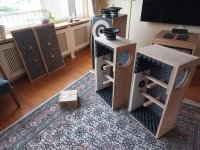 IMG_20230315_174503.jpg634.9 KB · Views: 173
IMG_20230315_174503.jpg634.9 KB · Views: 173 -
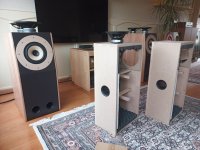 IMG_20230315_174549.jpg425 KB · Views: 162
IMG_20230315_174549.jpg425 KB · Views: 162 -
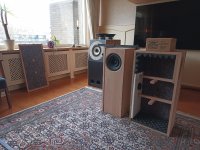 IMG_20230315_175144.jpg608.4 KB · Views: 178
IMG_20230315_175144.jpg608.4 KB · Views: 178 -
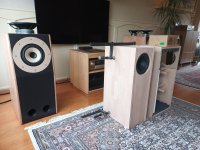 IMG_20230315_175155.jpg479.9 KB · Views: 157
IMG_20230315_175155.jpg479.9 KB · Views: 157 -
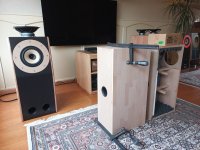 IMG_20230315_175226.jpg450.7 KB · Views: 155
IMG_20230315_175226.jpg450.7 KB · Views: 155 -
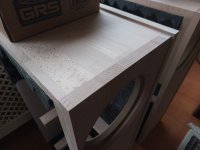 IMG_20230315_175917.jpg391.8 KB · Views: 157
IMG_20230315_175917.jpg391.8 KB · Views: 157 -
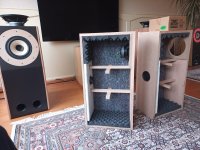 IMG_20230315_175343.jpg556.7 KB · Views: 193
IMG_20230315_175343.jpg556.7 KB · Views: 193 -
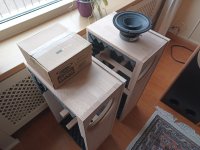 IMG_20230315_175924.jpg422 KB · Views: 202
IMG_20230315_175924.jpg422 KB · Views: 202 -
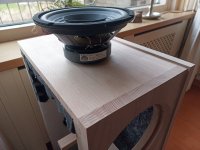 IMG_20230315_175939.jpg445.1 KB · Views: 190
IMG_20230315_175939.jpg445.1 KB · Views: 190
i have to correct myself.
Visaton BG20 has a textile surround.
I had in mind it was of paper but its textile type. My favourite type of surround.
So BG20 is a fine fullrange driver in my eyes
Visaton BG20 has a textile surround.
I had in mind it was of paper but its textile type. My favourite type of surround.
So BG20 is a fine fullrange driver in my eyes
I am doing a project, bass reflex with Beyma 8 agn.
This one has a pretty stiff paper surround.
I will put aluminium foil on both sides. But leave the surround unchanged.
This diy fellow changed the paper surround for a foam surround.
https://www.diyaudio.rs/topic/7866-beyma-8-agn-upgrade/
I can read the thread its in Yugoslav language.
Beyma 8 agn became popular with the horn named "the beast" in German "das Viech".
This one has a pretty stiff paper surround.
I will put aluminium foil on both sides. But leave the surround unchanged.
This diy fellow changed the paper surround for a foam surround.
https://www.diyaudio.rs/topic/7866-beyma-8-agn-upgrade/
I can read the thread its in Yugoslav language.
Beyma 8 agn became popular with the horn named "the beast" in German "das Viech".
Attachments
- Home
- Loudspeakers
- Full Range
- GRS 8FR-8 Full Range Low Budget Project
